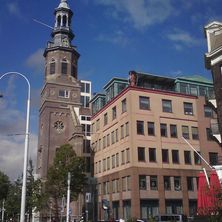

Across the Oosterpark on Linnaeusstraat one notices an obvious mismatch: a 19-th century church tower almost flush with a row of modern buildings. The Muiderkerk was built in 19th century as the twelfth Dutch Reformed Church in Amsterdam. Initially, the Reformed community around the Muiderpoort station used the Oosterparkkerk church on the western side of the park for their services, but the distance had become something of an issue, therefore, a new church was built on this side. The Reformed church did not want to be intimidated by the Catholics, who at that time had built a large number of institutions in the area: Our Lady's Hospice, the St. Boniface Church as well as a number of Catholic boys’ and girls' schools. Thus, the construction costs were almost four times as high as for a number of similar new Reformed buildings. The church, which received the name Muiderkerk (the town of Muiden lies about 12 km to the east of Amsterdam) was designed by the architect Vixseboxse. The hall of the church has been designed in the shape of a Greek cross, while the tower - in Neo-Renaissance style. The tall slender tower, which ensured that the Catholics were literally outdone, was crowned by an open lantern and a gilt rooster weathervane, typical of Protestant churches all over Northern Europe.
On October 31, 1989 the neighborhood witnessed a ravaging fire, which was probably caused by the plumbing repair work being done on the roof. The then minister of the Reformed Muider community, H. van Olst, spoke of "a fire that swept through the Church like a tornado." After the inspection it became evident that the tower was spared and will not have to be knocked down. However, the rest of the church and the adjacent buildings, such as the verger, the community buildings and the pastor house, could not be saved and had to be demolished. The despair among the congregation was enormous and the big question about what was to happen to the tower greatly affected the community? The Muider congregation was temporarily allowed to use the Oosterkerk, however the real lifesaver came from the Royal Tropical Institute down the street. Together with the institute, the church drafted construction plans for the entire site, which included incorporating the surviving tower into the new modern buildings.
Part of the new construction was intended as the church, while the rest of the new construction was intended for other purposes, such as offices and classrooms of the Royal Tropical Institute. NINSEE, The National Institute for the Dutch Slavery in the Past also received a place here. In 1997 the new building, designed by the architect Hoogevest, was opened. The tower has been connected to the new building through a glass portal and the new church hall has been designed as a simple rectangle. The front and back of the church hall feature stained-glass windows which originally come from the former Elthetokerk (entry number 10). The Muiderkerk congregation could at last return to its new facility.
However, the saved tower slowly fell into disrepair. In its upper part the damage from the fire was still quite visible. However, the Reformed church had no money for further restoration. As a result, in 2011 the tower was sold for the symbolic price of 1 euro for redevelopment. At the moments its ownership and occupancy remains unclear although it seems the Reformed church still has a presence here. In any case, the tower has again been saved from demolition and will remain as an important landmark and an easily recognizable spire in the skyline along the Linnaeusstraat.